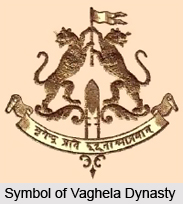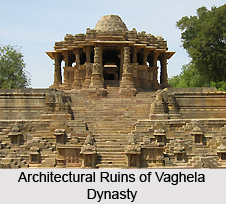 Vaghela Dynasty in Gujarat is one of the most ancient dynasties in the history of Gujarat. The Vagehela Dynasty was concentrated in the town of Dholka. The Vaghela came into existence under the umbrella of Solanki Dynasty. The Solankis ruled Gujarat in the early phase of the medieval history that is the 10th to 13th Century.
Vaghela Dynasty in Gujarat is one of the most ancient dynasties in the history of Gujarat. The Vagehela Dynasty was concentrated in the town of Dholka. The Vaghela came into existence under the umbrella of Solanki Dynasty. The Solankis ruled Gujarat in the early phase of the medieval history that is the 10th to 13th Century.
Vaghela, a Kshatriya name is one of the four Varnas in Hinduism. It comprises the military and noble order of the traditional Vedic-Hindu social system as outlined by the Vedas and the Laws of Manu. Lord Rama, Lord Krishna, Lord Buddha and Lord Mahavira all belonged to this social order.
The entire administration came under the under the control of Vaghela Dynasty when the Solankis declined in the mid of the 13th Century. By 1243 AD, the Vaghelas were become powerful ruling class in Gujarat. They restored the political, social and economic stability of Gujarat in the latter half of the 13th century, and the Vaghela kings and officials were dedicated to the patrons of the arts and temple-building. They established a strong and most powerful ruling structure in Gujarat for 76 years. They expanded their dynasty to all of Gujarat, north in Rajasthan, west in Madhya Pradesh and north in Maharashtra.
The two prominent rulers of this dynasty, Virdhaval (c. 1243 - c. 1262) and Vishaldev (c. 1243 - c. 1262), were responsible for consolidating the stabilizing the prosperity of Gujarat after the fall of the Solanki Dynasty. Virdhaval was the first Vaghela king, and two of his Jain minister brothers, who were also his two distinguished Dewans (chief ministers), Vastupal and Tejpal, built the exquisite Dilwara Temples on Mount Abu in Rajasthan, and temples at the Girnar and Shetrunjay hills. His successor Vishaldev built temples at Dabhoi and founded Vishalnagar. Then Sarangadev (c. 1275 - c. 1297) ruled for sometimes. The last ruler of Vaghela Dynasty was Karandev (c. 1297-1304). Karandev was the last Vaghela king and also the last Hindu ruler of Gujarat, who died in the 1304 conquest of Gujarat by Ala-ud-din Khilji, Sultan of Delhi. With his defeat Gujarat not only became part of the Muslim empire but the Rajputs hold over Gujarat lost forever.
Raj Solanki had two wives. He issued two sons. The first Solanki king was one of the famous kings of Patan, Mulraj Solanki was the son of first queen who was the sister of Samantsinh Chavada king of Patan from Chavada Dynasty. The second queen who was the sister of Lakhaji Jadeja (Lakho Fulani) had son named Rakhayat. Rakhyat married with Raymati and issued son named Vyaghrdeo. She kept him in Vyaghreshvari Mataji`s temple at jungle of Aatkot. Their son was protected by Vyaghreshvari Mataji so he was known by Vyaghradeo and after him, his dynasty was known as "Vaghela" or "Baghel" or "Waghela"
 The Vaghelas were Rajput clan of the Solanki rulers of Anhilwad. Lawan Prasad, a general in the army of Bhimdev-II Solanki gained control over an area known as Dhavalgadh, around present day Dholka. During the later years of Bhimdev-II`s reign, due to the weak political structure and civil strife, Lawan Prasad rebelled against the king and took complete control over the areas of Dhawalgadh and Dhandhuka, and also some areas in the south of Gujarat. This rebellion laid the foundation of the Vaghela Dynasty for the greater resistance and resultant was the overthrowing of the Solanki rulers from Anhilwar. The final attack on Anhilwar during the reign of Tribhuwanpal Solanki, was made by Vishaldev Vaghela, the grandson of Lawan Prasad. Vishaldev`s father, Vir Dhaval Vaghela already started to conquer all the territories belonging to the Solank. Thus it had greatly increased his dominions as well his military powers. Many historians consider Vir Dhaval to be the first strongest Vaghela ruler of Gujarat, as the major increase of his power and control of the various areas of Gujarat.
The Vaghelas were Rajput clan of the Solanki rulers of Anhilwad. Lawan Prasad, a general in the army of Bhimdev-II Solanki gained control over an area known as Dhavalgadh, around present day Dholka. During the later years of Bhimdev-II`s reign, due to the weak political structure and civil strife, Lawan Prasad rebelled against the king and took complete control over the areas of Dhawalgadh and Dhandhuka, and also some areas in the south of Gujarat. This rebellion laid the foundation of the Vaghela Dynasty for the greater resistance and resultant was the overthrowing of the Solanki rulers from Anhilwar. The final attack on Anhilwar during the reign of Tribhuwanpal Solanki, was made by Vishaldev Vaghela, the grandson of Lawan Prasad. Vishaldev`s father, Vir Dhaval Vaghela already started to conquer all the territories belonging to the Solank. Thus it had greatly increased his dominions as well his military powers. Many historians consider Vir Dhaval to be the first strongest Vaghela ruler of Gujarat, as the major increase of his power and control of the various areas of Gujarat.
Vishaldev Vaghela is most widely known and was perhaps the most celebrated of the Vaghela rulers of Gujarat. He won military campaigns against Malwa (Parmara) and was able to largely bring under control the various rebelling factions of the degraded kingdom of the last Solanki ruler, Tribhuwanpal. Vishaldev was also a great patron of learning and is known for his contributions in encouraging in the arts, poetry and religious pageantry. Vishaldev, after a long and successful reign, was succeeded by his son Arjundev, who in turn was succeeded by his son Sarangdev. Little is known about the reigns of these Vaghela rulers, and they seem to have enjoyed a reasonably peaceful and prosperous reign in the midst of the turmoil of the Muslim invasion.
Sarangdev Vaghela was succeeded by his son, brave, and unbending hero, Karandev, also known in history as Karan `Ghelo. Karandev was the last in the line of the Vaghela chieftains of Anhilwar, and also the last Rajput ruler to have held control of most of Gujarat and Saurashtra. Just two years after ascending the throne of Anhilwar, Karandev was engaged by the troops of Ala-Ud-Din Khilji, the Muslim ruler of Delhi, where he was killed. Karandev gave a brave resistance, and after a vigorous struggle, the Rajputs finally retreated and Anhilwar fell in the hands of the Muslim.The city was plundered and ravaged. Alaf Khan captured the beautiful wife of Karandev, and sent her to Delhi as a victory present to the Sultan. He then moved west and destroyed once again, the grand temple of Someshwar (Somnatha) at Prabhas Pattan. Karandev, in the meantime, broken and dishonored at losing his county, his possessions and his wife, retreated to Devgadh in Deccan. He refused to give in to the request of the Muslims to surrender, and started to gather a force to engage the Muslims again at Anhilwar. Karandev lost this war and escaped with her Queen Kamaladevi (Kauladevi) and daughter Devaldevi. Karandev and Devaldevi went to the Devgadh. The two prince of Karandev and one of his Queen of Jadeja dynasty of Kutch were sent to the Kutch- Saurashtra region. The Sultan of Delhi, sent another force under a slave general Kafur, to attack Karandev in Devgadh, and bring back to him, his daughter, the princess Devaldevi. Thus, ended the rule of the last Hindu ruler of Anhilwa. Broken and disillusioned, Karandev refused to surrender and spent the last of his days roaming the lands of the country, he once ruled. However, he is still respected for his brave resistance and his unbending courage. He came to be known as Karan Ghelo for this reason.
After the end of Karandev`s Rule, Gujarat was broken up in the many parts. Rajputs or Muslims could not control whole Gujarat after Vaghela dynasty. The Vaghelas Divided in the whole Gujarat. The villages of Vaghela Dynasty are located near Ahmedabad, Kalol, Rapar(Kutch), Kadi and many other parts.






































